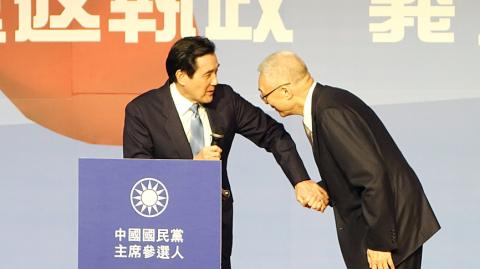Former president Ma Ying-jeou (馬英九) yesterday hurled insults at KMT Chairwoman Hung Hsiu-chu’s (洪秀柱) team and cross-strait policy platform at a solidarity rally held for Chinese Nationalist Party (KMT) chairperson candidate Wu Den-yih’s (吳敦義) campaign.
Ma took aim at a recent controversy, when it was revealed that “dummy members,” had been signed to the party en masse, saying that the practice “used to be the Democratic Progressive Party’s trick, not the KMT’s.”
Addressing accusations that members with organized crime backgrounds joined the party, Ma said the reports have had a terrible effect on the party, and such “pests” must be eradicated for the KMT to regain its “sunshine image.”

Photo: George Tsorng, Taipei Times
The KMT has “a clear understanding of right and wrong, upholds morality and takes its connections with party members seriously, characteristics that have arisen from the party’s 100-year history,” he said.
“However, there are some party comrades that have been ranting at their own brethren; there are even reports alleging that certain party members plan to launch a political vendetta against me, accusing me of being to blame for devastating the party and the nation,” Ma said.
One of the “comrades” Ma was referring to is understood to be KMT Central Policy Committee director Alex Tsai (蔡正元), who has been involved in a series of heated spats and exchanges with Ma’s office, the most recent regarding Ma’s acknowledgment that Chiang Kai-shek (蔣介石) should be held accountable for the 228 Incident.
Tsai responded that then-Taiwan governor Chen Yi (陳儀), who ordered police and military action against protesters, was less corrupt than Ma.
The vendetta that Ma mentioned is believed to relate to forums organized by Chang Ya-chung (張亞中), a close aide of Hung’s and the principal of the “Sun Yat-sen School” set up by Hung.
The school, launched at the beginning of this month, was said to be “for the appraisal of past KMT leaders and their achievements and misdeeds.”
The school evaluated former presidents Chiang Kai-shek on March 2, Chiang Ching-kuo (蔣經國) on March 9 and Lee Teng-hui (李登輝) on Thursday.
Ma is scheduled to be discussed on Thursday next week.
Ma also repeated that the so-called “1992” consensus has benefited Taiwan greatly and was “not a ‘consensus’ between the KMT and the Chinese Communist Party, but one reached, under the direction of former president Lee Teng-hui, between Taiwan’s Mainland Affairs Council and China’s Association for Relations Across the Taiwan Straits.”
“One China, different interpretations” has garnered a high level of support, he said, adding that it should not be “arbitrarily overlooked, revised or abolished.”
“It should not be changed to [Hung’s] ‘one China, same interpretation,’ which has left many of our supporters disconcerted,” Ma said.
The “1992 consensus” refers to a supposed understanding reached during the cross-strait talks in 1992 that both Taiwan and China acknowledge that there is “one China,” with each side having its own interpretation of what that means.
In 2006 former Mainland Affairs Council minister Su Chi (蘇起) admitted he made up the term in 2000, before the KMT handed power to the Democratic Progressive Party.

ANOTHER EMERGES: The CWA yesterday said this year’s fourth storm of the typhoon season had formed in the South China Sea, but was not expected to affect Taiwan Tropical Storm Gaemi has intensified slightly as it heads toward Taiwan, where it is expected to affect the country in the coming days, the Central Weather Administration (CWA) said yesterday. As of 8am yesterday, the 120km-radius storm was 800km southeast of Oluanpi (鵝鑾鼻), Taiwan’s southernmost tip, moving at 9kph northwest, the agency said. A sea warning for Gaemi could be issued tonight at the earliest, it said, adding that the storm is projected to be closest to Taiwan on Wednesday or Thursday. Gaemi’s potential effect on Taiwan remains unclear, as that would depend on its direction, radius and intensity, forecasters said. Former Weather Forecast

As COVID-19 cases in Japan have been increasing for 10 consecutive weeks, people should get vaccinated before visiting the nation, the Centers for Disease Control (CDC) said. The centers reported 773 hospitalizations and 124 deaths related to COVID-19 in Taiwan last week. CDC Epidemic Intelligence Center Director Guo Hung-wei (郭宏偉) on Tuesday said the number of weekly COVID-19 cases reported in Japan has been increasing since mid-May and surpassed 55,000 cases from July 8 to July 14. The average number of COVID-19 patients at Japan’s healthcare facilities that week was also 1.39 times that of the week before and KP.3 is the dominant

The Chinese Communist Party’s (CCP) working group for Taiwan-related policies is likely to be upgraded to a committee-level body, a report commissioned by the Mainland Affairs Council (MAC) said. As Chinese President Xi Jinping (習近平) is increasingly likely to upgrade the CCP’s Central Leading Group for Taiwan Affairs, Taiwanese authorities should prepare by researching Xi and the CCP, the report said. At the third plenary session of the 20th Central Committee of the CCP, which ended on Thursday last week, the party set a target of 2029 for the completion of some tasks, meaning that Xi is likely preparing to

US-CHINA TRADE DISPUTE: Despite Beijing’s offer of preferential treatment, the lure of China has dimmed as Taiwanese and international investors move out Japan and the US have become the favored destinations for Taiwanese graduates as China’s attraction has waned over the years, the Ministry of Labor said. According to the ministry’s latest income and employment advisory published this month, 3,215 Taiwanese university graduates from the class of 2020 went to Japan, surpassing for the first time the 2,881 graduates who went to China. A total of 2,300 graduates from the class of 2021 went to the US, compared with the 2,262 who went to China, the document showed. The trend continued for the class of 2023, of whom 1,460 went to Japan, 1,334 went to